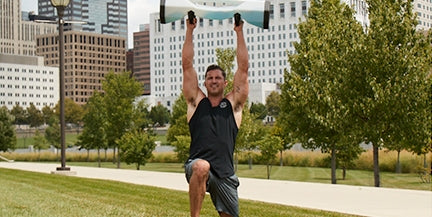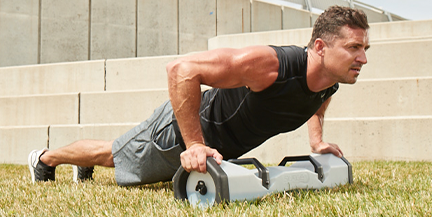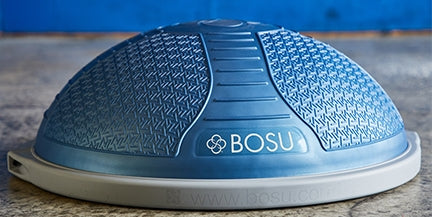BOSU® Balance Training Science, Function and Results

Functional balance training (FBT) experts and researchers describe FBT as an important departure from traditional training approaches. FBT focuses on training movement, rather than muscles in isolation. Generally, functional training is tied to balance training, sport, activity, skill practice, or occupational-specific practice. In other words, its outcome translates to real-life activity and sport.
Balance and stabilization training can simply be thought of as a position or series of positions that occur during movement, and that are maintained when opposing forces equalize one another. Little or no movement occurs at the stabilized joint(s). Applied to movement, this means that muscles on both sides of a joint(s) contribute to stabilization via a co-contraction of agonist and antagonistic muscles. Co-contraction of muscles on either side of a joint(s) contribute to a body part or body position being maintained in a desired, or intended symmetry or asymmetry. In essence, this is balance and represents an important aspect of functional movement and training! However, the transfer to functionality occurs when appropriate stabilization is combined with movement.
Functional balance training. Functional balance training goes beyond contributing to skilled movement by training not only stabilizing or static muscular contributions, but also training dynamic movement patterns simultaneously. It is likely that most skilled movement, of any kind, simultaneously requires both stabilizing force production and bodily movement.
Balance defined. Balance represents an ability to stabilize and maintain a desired body position. Balance can also be thought of as correct, or efficient, positioning of a body part or the entire body, whether static, or moving dynamically.
The science behind using the BOSU® Balance Trainer? From a broader programming and training perspective, at any level, strong muscles can produce higher forces and can exhibit more endurance at submaximal levels of effort, when compared to weak muscles. Strong muscles can produce higher levels of, and sustain force production (muscular endurance), which will aid the body in “learning” movements, as well as helping to maintain consistent and high-levels of performance. Strength provides the foundation for muscular endurance, agility, coordination and balance. But if skillful movement is desired, non-specific strength must be transitioned to be able to handle the center of mass, as it relates to balance, when it is outside the base of support. This type of movement capability is required every day in life and athletics. Examples include when a person stumbles and regains balance, or an athlete aggressively decelerates or makes a sharp cut.
Natural and functional movement is directly related to the harmonious workings of joints, muscles and the neurological system. Our neurological systems interact with our musculoskeletal system in a coordinated and complex manner. Using stability or balance training on an unstable surface, and closed chain exercise (CCE), is the perfect way to stimulate and train this complex interaction of the body. After all, this is the way we normally function every moment of our lives. Think about common activities and it quickly becomes apparent that most movements are dependent on coordinated balance and changing force output throughout the body. Demands placed on the body during stability training, balance training and closed chain exercise vary dramatically, but replicate daily life and sport situations. From moment to moment, the body strives to maintain balance and to integrate the responses into safe, skilled movement.
This type of training must intentionally be introduced to your training program. “It” doesn’t happen accidentally or on its own.
Many of the responses made by the body to balance challenges (external stimulus, visual affect, points of contact and movement) are referred to as automatic postural reactions. These responses occur before voluntary movement and afterreflexes yet have commonalities with both.
Just as high-level sport performance represents a picture of extraordinary neuromuscular accomplishment, at even its simplest level, so does balance training and its maintenance. The key difference in perspective is that balance training is accessible to all, easy to do, fun and self-gratifying! BOSU® Balance Training can be scaled to any capability.
Yet any skill level, as it relates to movement, is dependent on the intricate and precise participation of the central nervous system as it acts upon muscles, after receiving information. It is only through a complex, automatic integration of several sensory systems of the body, that we can accurately position our bodies, perceive where and how the body is positioned in space relative to our position, and easily adjust how much force we develop in our muscles to maintain precise performance boundaries, assure safe execution of the movement and maintain or recover alignment and center of gravity without a second thought. It is easy to understand how this type of training has a high-level of transfer to life movement skills.
Functional balance training incorporates the concepts of balance/stability training and closed chain exercise (CCE) by requiring the body’s natural motor reflexes to react as an integrated unit. In other words, the whole body is challenged to participate in order to maintain correct posture and balance while moving. The inclusion of activities that involve the entire body in a dynamic and coordinated fashion represents the development of functional fitness. This type of fitness is easily transferred to daily tasks, recreation and sport. Stabilization and functional training can both be integrated into closed chain and open chain exercise. But, remember that functional training ultimately trains movement, not just stabilizing contractions that contribute to effective movement. Stability and balance training represent two aspects of training that fit under the “functional training umbrella.”
Righting, Protective And Equilibrium Reactions
The antigravity, balance and power producing capacity of the body can be simply thought of, in terms of physical skills, as righting, protective and equilibrium reactions. How do you train these key components of performance? Enter unstable training surfaces (UST) like the BOSU® Balance Trainer.
Automatic righting reactions maintain or restore body alignment as it relates to the position of the head, trunk and limbs. Muscle spindles monitor the rate at which muscles lengthen and play a big role in maintaining balance at rest. Spindle feedback helps you stay centered while standing on the dome and visually tracking your hand from in front of the body to the side, and then to an overhead position. Muscle spindles also play a role when you try to maintain balance over the center of the dome with your eyes closed. When a body part is suddenly displaced, righting reactionscome into play. An arm or leg shooting up or out to the side counters the weight displacement and is largely automatic, thanks to sensory feedback coming from the muscle spindles. If weight shifts are slow and controlled, constant muscular activity and adjustment is subtle, rather than dramatic. Think of these implications as it relates to an older person avoiding a fall or one of the ESPN plays of the day.
Equilibrium reactions can be thought of as an integration of righting and protective reactions as the body fine tunes, through practice, a coordinated, complex and automatic response. The aim of the response is to preserve or restore balance during any type of activity. Reactions and attempts to maintain balance are common whenever the center of gravity of the body is displaced over any base of support. When centered on the air-filled BOSU® Balance Trainer dome, this displacement is ever present as the properties of the dome provide an unstable gel-like surface that continually attempts to displace the body’s center of gravity. This maintains a learning environment where you are always out of balance because the stimulus is constantly changing, which means you are always training balance!
The BOSU® Balance Trainer
The BOSU® Balance Trainer is a “feel me product.” Talking about balance training is one thing. However, to understand and learn what the Balance Trainer can teach, it must be felt and experienced by getting on the product. Instant feedback with regard to positioning, balance, strength, power, mobility and stability are but a few of the feedback loops that will be developed and tie to the concept of invisible learning.
Invisible learning occurs via proprioceptive feedback that is provided instantly with regard to positioning, mobility, stability, body control and force/power output. Even without coaching and cuing, the body can solve the movement puzzle as it relates to quality movement, or improving upon movement faults, when presented with the right stimulus and progression. The body can “figure out” how to correct poor movement patterning and movement faults as it relates to positioning and stability because of a constant barrage of nonverbal proprioceptive feedback provided to the user when exercising on the BOSU®® Balance Trainer.
Why The BOSU® Balance Trainer?
The science and thought behind the Balance Trainer is in-place, so let’s get to it…
Six Benefits of BOSU® Training:
1. Versatility for all fitness levels. From kids to frail elderly adults to elite athletes-- programming, skill sequencing and strength/power development can carefully be orchestrated and scaled to any capability.
2. Adaptability for group fitness, small group training, personal training, and athletic training. While BOSU®programming can be formatted for large group fitness classes, its strength also lies in using it for circuit, small group, and one on one training, even if for only a short part of the session.
3. Flexibility to progress or regress any exercise. While movement skills will continue to improve with proper progressions, no one will ever “master” the BOSU® Balance Trainer. There is always another challenge around every corner. Simultaneously, using appropriate progressions, anyone should be able to exercise safely and successfully, regardless of fitness level.
4. Integrate with any type of fitness training. People have said, “Everything is better with BOSU®.” The Balance Trainer is very compatible with various training methodologies and other training equipment, depending on the training goal. This is evident in the industry today, as many programs mix and match sessions pairing BOSU® Programming with many different training approaches (circuit, boot camp, Pilates, balance, etc.) and types of equipment such as suspension training, ropes, elastic resistance, harnesses, and plyo boxes to name a few.
5. Injury prevention, rehabilitation, and performance improvement. Many people pigeonhole BOSU® training into balance only outcomes, but training with it can contribute to a bigger aspect of fitness development, injury prevention and reestablishing function after injury. Secondary fitness characteristics can be trained that include Coordination, Agility, Reactivity, Balance, Strength and Speed (CARBSS). The sum of all these key qualities of athleticism culminates in an expression of Power (force/speed), which is key to improved performance at any level. And, you really are training stability, which more accurately should be called motor control. So in other words, benefits flow when you have a tool that helps you to focus on and train motor control, not in only one position, but also during movement!
6. BOSU® training is skill-based and fun. Little victories with regard to eliminating movement faults, skill acquisition and moving with more rhythm, better timing, balance, fluidity and confidence--is why BOSU® training remains so popular worldwide. The Balance Trainer is used by top coaches, trainers and fitness instructors worldwide. At the end of the day, “fun and results,” undeniably, must be part of the training picture.
Nervous System Training, Balance and UST (unstable surface training)
The BOSU® Balance Trainer provides a unique blend of stability and instability unlike any other product before it or since. The base is stable and rooted to the ground, and the dome provides a unique enriched proprioceptive training surface that is easy and safe enough for beginners to stand on, yet can be infinitely challenging for the most advanced athletes. It can be used to support any part of the body and is incredibly versatile for a wide range of training objectives. It can also be turned platform side up, which provides unique advantages for many other specific applications, such as performing planks, pushups, etc.
The BOSU® Balance Trainer is extremely effective for training the nervous system to re-pattern fundamental reflexes that make athletes capable of loading and exploding faster under athletic circumstances. Everyone moves with a certain amount of inefficiency – some people more, other people less. But because your body and brain have been habituated to standing on the ground since you were approximately 1 year old, you are not aware of all the inefficiency and compensatory movement you actually engage in to walk, run, jump, etc. Those who argue that you should not use UST because you don’t play most sports on unstable surfaces should ask themselves if they play with barbells on their backs. You don’t engage in sports lying on the floor with a foam roller either, but that is not a sensible reason to avoid rolling. You get my point.
On the other side, UST surfaces are not appropriate for heavy lifting, nor max strength or power gains in-of-themselves, but it is arguable they can contribute to those gains when incorporated correctly. Though the BOSU® Balance Trainer is used incorrectly to try and achieve these training goals by some trainers, trainers in-the-know would not use them in this manner.
Key Point: Don’t confuse the “specificity of training” with the “specificity of the training stimulus” and how it fits together within a complete training approach.
Balance is one of your body’s highest priorities because losing balance--body control or stabilization--can be life threatening, cause injury and bottom line, performance and efficiency of movement erode. Your body responds to imbalance reflexively by increasing tension and moving toward a bracing (stabilization) position. This happens to some degree when your body senses imbalance, even if you cannot visually observe this reaction with the naked eye.
What makes the BOSU® Balance Trainer so effective is that as you increase the balance challenge, you do not appreciably increase the risk of falling or injury. Therefore, you can practice being out of balance in a relatively controlled environment, which gives you a better chance to respond with a reflexive righting response in the real world. The exit strategy on a BOSU® Balance Trainer is simple. All you have to do is get your foot to the floor if you lose balance. No other product creates the same spectrum of challenge with such a low degree of risk. This gives you the ability to strategically retrain your balance reflexes and keep reflexive patterning primed, which creates carryover to the athletic field and activities of daily life (ADLs).
Final Summary On BOSU® Balance Training
Training on the BOSU® Balance Trainer does not just get you good at balancing on the Balance Trainer as some critics who do not understand the depth of training on unstable surfaces might think. The whole point of BOSU® training is to make athletes better at ground based movement, which is what top trainers, athletes and normal folks are doing world-wide, while using the BOSU® Balance Trainer.
Remember…The BOSU® Balance Trainer provides a unique blend of stability and instability unlike any other product before it or since. The base is stable and rooted to the ground, and the dome provides a unique enriched proprioceptive training surface that is easy and safe enough for beginners to stand on, yet can be infinitely challenging for the most advanced athletes. It can be used to support any part of the body and is incredibly versatile for a wide range of training objectives. It can also be turned platform side up, which provides unique advantages for many other specific and safe applications.
The BOSU® Balance Trainer is extremely effective for training the nervous system to re-pattern fundamental reflexes that make athletes capable of loading and exploding faster under athletic circumstances. Everyone moves with a certain amount of inefficiency – some people more, other people less. But because your body and brain have been habituated to standing on the ground since you were approximately 1 year old, you are not aware of all the inefficiency and compensatory movement you actually engage in to walk, run, jump, etc.
UST surfaces are not ideal for heavy lifting, nor max strength or power gains in of themselves, but it is arguable they can contribute to those gains when incorporated correctly.
Key Point: Don’t confuse the “specificity of training” with the “specificity of the training stimulus” and how it fits together within a complete training approach.
BOSU® Balance Training
Training on the BOSU® Balance Trainer does not just get you good at balancing on it as some critics who do not understand the depth of balance training on the BOSU® dome surface, as it relates to benefits. The whole point of BOSU® training is to make athletes, and regular fitness enthusiasts around the world, better at ground based movement.
Bottom line: If you want to move quicker, sprint faster, lift heavier, or express power more efficiently, then you’ve got to train balance, reactivity and motor control, which is what top trainers, athletes and consumers know, and are doing so world-wide. The BOSU® Balance Trainer is a key piece of the programming puzzle to make that happen.
Let me leave you with these 3-points:
1. Balance…represents the ability to maintain equilibrium/body control when stationary or moving, whether center of gravity/mass (COG/COM) is over the base of support (BOS), or not.
2. BOSU® Athletic Balance… is reactive/reflexive capability that allows the body to adequately respond to a changing, unpredictable environment, while maintaining perfect positioning and body control. Period!
3. Everyone--regardless of age, capability or training goals--needs a good dose of #’s 1 & 2, as part of a portfolio that represents a complete approach to training.
Douglas Brooks, MS, Exercise Physiologist, is the Director of Programming for Hedstrom Fitness, BOSU® and SURGE®. The former Kona Ironman® triathlete directed Athlete Conditioning for Sugar Bowl Ski Academy for 8-years, working with elite junior and professional athletes. Douglas was inducted into the U.S. National Fitness Hall of Fame and has been honored by Can-Fit-Pro as the International Presenter of the Year. Coach Brooks is the author of numerous fitness education books, and was the recipient of the IDEA Personal Trainer of the Year Award.



